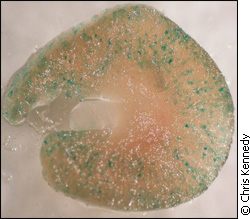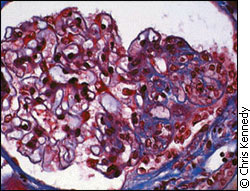
|
| Dr. Chris Kennedy believes that the use of a newly tailored non-steroidal anti-inflammatory drug (NSAID) at the onset of kidney disease could stall its progression or even reverse the damage it causes. NSAIDs net more than a billion dollars each year for the pharmaceutical industry, according to University of Ottawa professor and scientist Dr. Richard Hébert. These drugs, namely Celebrex, Bextra, and Vioxx, used for treatment of arthritis, are no longer on the market in Canada due to their detrimental side effects. However, Kennedy and Hébert are establishing the potential usefulness of NSAIDS in patients experiencing kidney dysfunction. "These drugs on the one hand have a number of good effects, but they also have a number of negative effects on the heart or cardiovascular system as well as in the kidney," Kennedy says. Replicating kidney disease Kennedy has worked to identify targets for treating kidney disease by reproducing the effects of kidney disease in mouse kidney filter cells. He looks at the genes being turned on or off under certain conditions and how the interior of the filter cell is responding and coping under those conditions. This will allow pharmaceutical companies to come up with more selective NSAIDs that will act downstream of the ones that already exist.
For example, Kennedy manipulates the kidney cells to mimic the conditions of diabetes by stretching and pulling them and controlling their sugar levels. In doing so, he has discovered that there is an increase in cox-1 and cox-2. Cox-2 is a main target of NSAIDs, often referred to as Cox-2 inhibitors. "We’ve noticed that in diabetes, by using cells from the collecting duct and by pre-treating these cells with glucose, there is an increase of cox-1 and cox-2 by five or six fold," Hébert says. "We know we can slow down this increase and reverse it with an inhibitor." Specifically, Kennedy has confirmed the presence of an enzyme that responds to stress in a cell, such as the stress brought on by kidney disease. This enzyme is called nicotinamide adenine dinucleotide phosphate-oxidase, or NADPH oxidase for short. Stressed kidney cells release a harmful substance produced by NADPH oxidase known as superoxide. Superoxide sets in motion a series of reactions within the cell that can eventually kill or significantly damage the cell. For the kidney, these cells are found in its filters called nephrons. Each kidney has about one million nephrons and when they die, the filtration function of the kidney is compromised.
"When we stretched the kidney cells, we found that we had turned this whole enzyme system on," Kennedy says. "Other people have found that if production of this enzyme is blocked in models of kidney disease, some of the damage that occurs can also be blocked." Kennedy has shown that turning on NADPH oxidase in the kidney's filtering cells leads to the generation of more cox-2, which is targeted by NSAIDs. "This could mean that NSAIDs would be a good thing for these types of cells in the context of diabetes and kidney disease, since these drugs would block a downstream target of NADPH oxidase activation," Kennedy explains. "In other words, if tailored properly by pharmaceutical companies, NSAIDs might be able to halt harmful NADPH oxidase or superoxide bursts." Hébert says that under normal circumstances, cox-2 does not do anything bad. In fact, scientists still do not see a role for cox with regard to kidney function. It is simply there without effect. "The level present under normal circumstances is so small that we cannot find a role for it unless we increase it artificially by inducing a disease," Hébert says. "Then, it affects the physiology of the nephrons, which once affected inhibit the function of the kidney." Long-term implications of NSAIDs One issue Hébert and his research team will study over the next five years is the long-term use of NSAIDs on the body, but specifically on the kidney. It is a concern because Hébert has showed that the collecting duct of the kidney can retain up to 67 per cent of everything that passes through it, which could include NSAIDs. "One thing is that we don't know a lot about the chronic infusion of NSAIDs, with regard to diabetes," Hébert says. Kennedy's research is funded by grants from the Canadian Institutes of Health Research, the Canadian Foundation for Innovation, and a Biomedical Research Scholarship from the Kidney Foundation of Canada. While still a long way off, the use of NSAIDs for treatment of kidney disease would be a major advancement because the two existing treatments for kidney disease at present, either transplantation or dialysis, are both very costly and invasive. Kennedy notes these high costs put a huge strain on Canada's health care system. "A lot of people are asking how sustainable our health care system is, and a big issue with treating kidney disease is that to be on dialysis runs around 70 to 80 thousand dollars per year, per person," Kennedy says. "Then there's the cost of drug therapies that patients have to be on, as well as the actual staff time, the machines, and filters." Coupled with the fact that there is still no cure for kidney disease, another motivation for Kennedy's research is the fact that kidney disease is rapidly increasing among Canadians.
"There's actually an increase in the number of people with chronic kidney disease that's growing at an average of 10 per cent per year," Kennedy says. "The epidemic of obesity and diabetes contributes to this as well as the aging population." Kennedy admits there are not as many people suffering from kidney disease as cancer or heart disease. For this reason, he says, there is not as much investment in kidney disease research. As a result, scientists pursuing kidney research have had a much slower jump making major breakthroughs, which Kennedy says need to be there to help those people. "If we can, in any way, enhance the quality of life for people already in that situation or prevent them from even getting there, that would be a major coup," Kennedy says. "Being able to lift some of the burden that is on the health care system is the goal as well."
|
|
|

